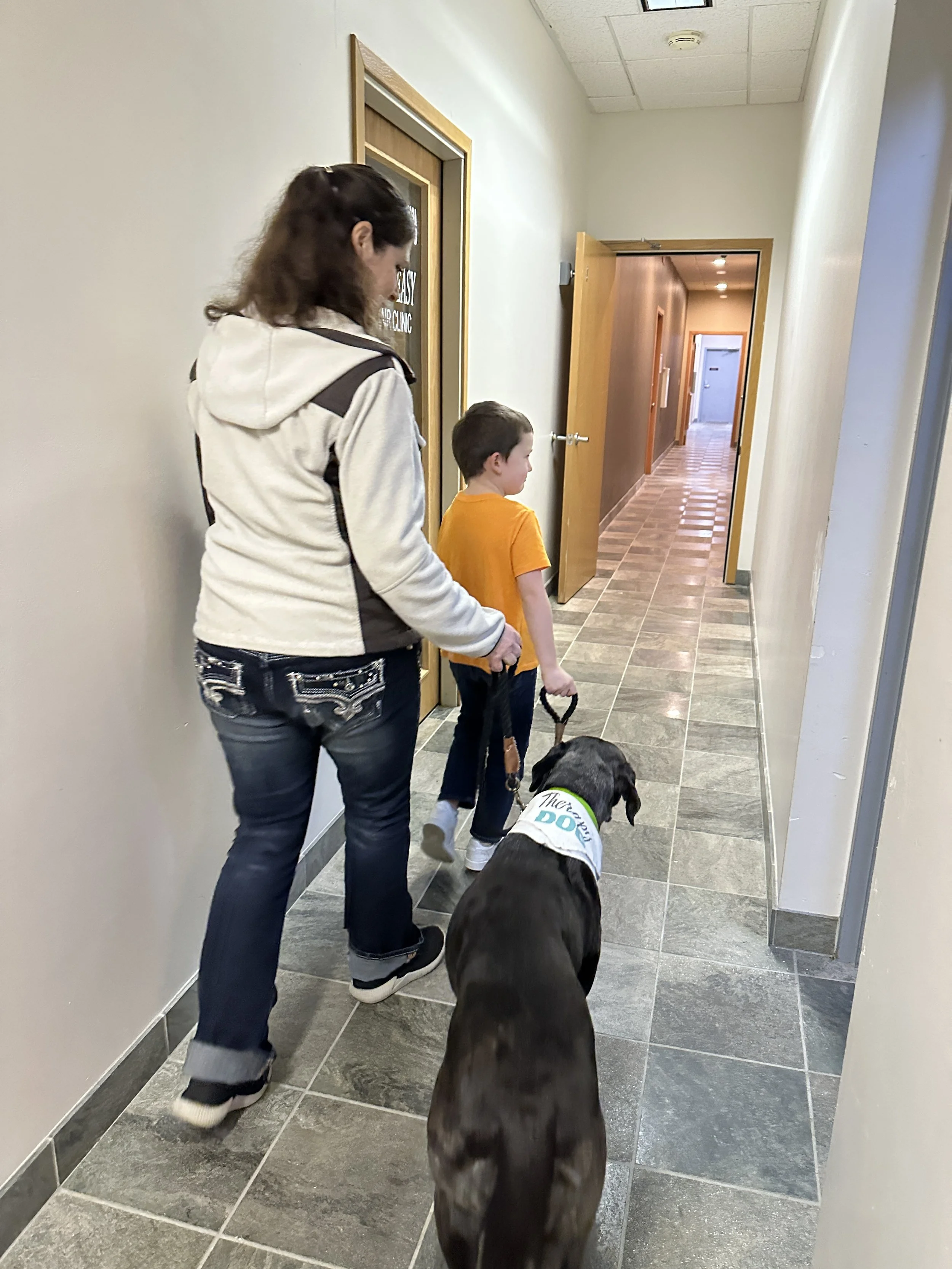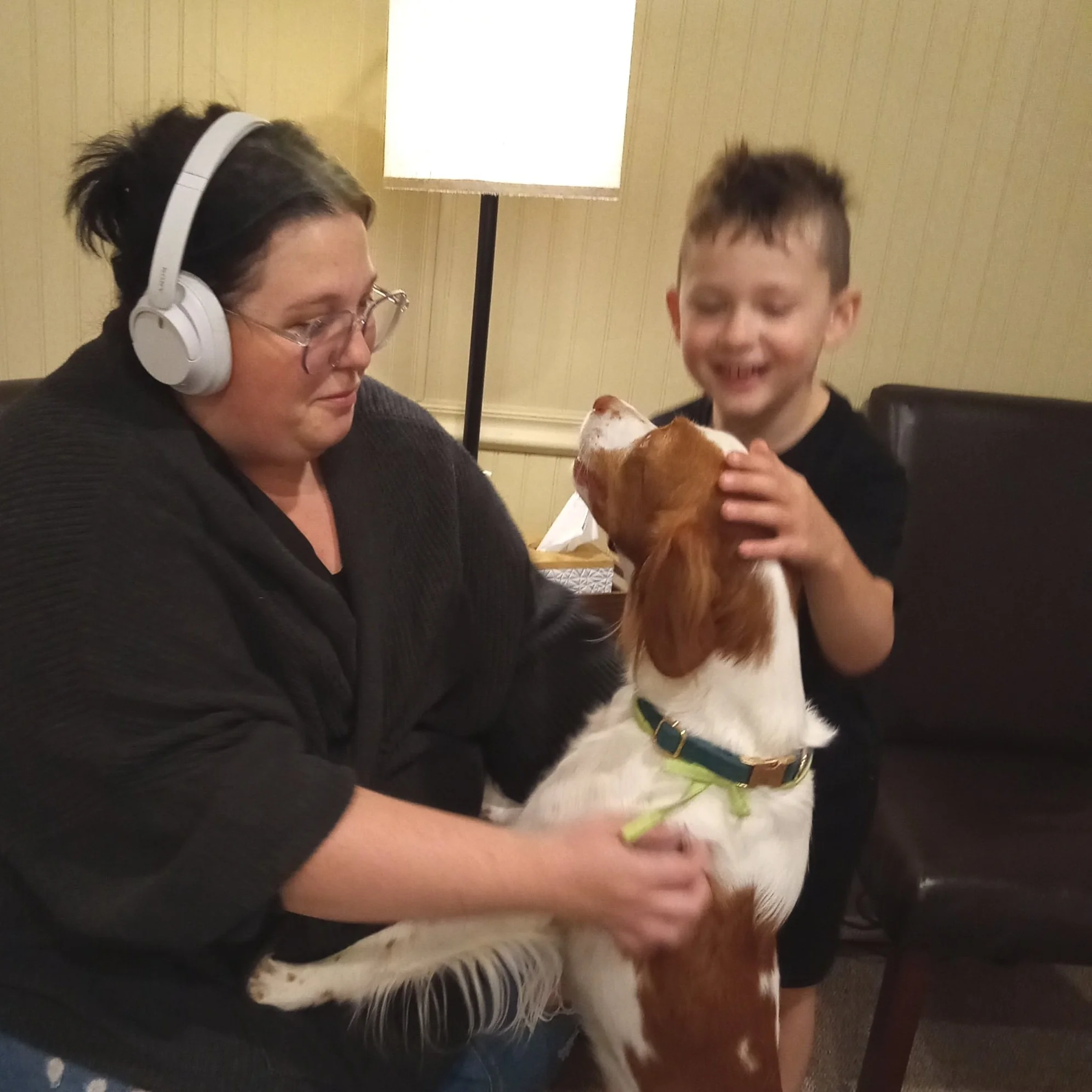5 Surprising Things I’ve Learned from 5 Years Partnering with a Speech Therapy Dog
Have you ever started on a venture and been surprised where you wound up?
When I first brought my dog Delta to work, I really thought it would be for the occasional special session for children who were struggling to make progress toward their communication goals.
In particular, I had a child whose anxiety-based refusals and self-aggression left me constantly struggling to find a way to connect with him, and I hoped bringing a dog would be my way into his world.
Fast forward a few years and those early experiences with Delta have propelled me deeply into the world of animal-assisted speech therapy, leading me to:
work with four different speech therapy dogs to date,
start the Speech Dogs website to provide resources and education about the topic
Here’s a few surprising things I have discovered on the journey:
Speech therapy dog Delta and I walk down the hall with a young client, helping him to transition calmly from the therapy room to his car.
When you click a link, it’s possibly an affiliate link and I will earn a small commission if you make a purchase. It doesn’t cost you anything extra. If I haven’t personally used and love the product, you won’t find it here!
#1 Speech therapy dogs are like potato chips…it’s hard to have just one.
Ok, I admit I’ve become a bit co-dependent on my speech therapy dog.
On the rare days I don’t have a dog present at work I feel lonely and bit limited in my tools for addressing more challenging behaviors.
Having more than one dog to work with allows them more down time between work days and keeps them fresh and excited to see whose leash and gear gets pulled out of the closet in the morning.
When starting out, I also underestimated the value of having different energy types for animal-assisted speech therapy activities.
Some kids (and families) really bond with Delta the LabraDane who is usually slow-moving and calm, while others seem to benefit from the more alerting, high activity level of the ever-wiggling Britannys Johnny Utah and Sky. When I was bringing my young dog Bodhi, his goofy and unexpected actions often elicited spontaneous communication from more reserved kids.
Unfortunately, a therapy dog’s working career is much shorter than a speech therapist’s and new candidates take time to train and acclimate to the work, so planning ahead toward retiring a therapy dog is important if you plan to routinely incorporate animal-assisted interventions in the future.
There is a limit to how many dogs you can have, or so my family keeps telling me.
#2 Kids can vary in their interest in the therapy dog from day to day.
I have a some kids who always want a dog in their session, and a few who never do. But sometimes I’m surprised when a particular child expresses a need for space when they typically show enjoyment of the therapy dog’s presence.
Tactile sensitivities and tolerance levels can vary a lot for some kids, so I’ve learned to always have a backup activity ready in case either dog or child is not wanting to interact that day.
Therapy dog Delta lies on a child’s work to get his attention during animal-assisted speech therapy. A therapy dog’s unexpected and goofy actions can help delight and engage clients to improve memorability of the session.
#3 You and your canine co-therapist won’t always see eye to eye.
I love my therapy dogs, I really do. But they are sentient beings with their own opinions and desires that don’t always align with mine.
It’s not often, but sometimes Delta gets a little pushy wanting attention from a child or caregiver when I’m wanting her to fade into the background for a moment; other times she looks at me blankly when I try to call her off her bed in a session where I know her presence will be helpful.
Wouldn’t it be wonderful if a therapy dog did exactly what we wanted when we wanted?
I try to appreciate those magical moments when my therapy dog anticipates a need or performs exactly as I hoped and simply let go of the times when that doesn’t happen.
#4 Incorporating a speech therapy dog requires you to be bilingual in human language and dog language.
I’ve found I can’t learn enough about the communication of dogs.
The occasional times I’ve had trouble have all been because I missed a signal (or more likely, a series of signals) my therapy dog was giving that they were uncomfortable with the situation.
Working closely with a highly qualified dog trainer, consulting with an animal behaviorist, and finding resources about dog psychology and body language aimed at dog professionals are an important investment of time and money to keep everyone safe and sessions productive.
Time spent observing other people’s dogs in public spaces, looking for signals of both comfort and anxiety, can help you refine your skills in this area as well.
Click here to get your FREE Therapy Dog Behavior Bingo Board.
For my favorite dog behavior resource, click here, but also check out the Favorite Products for Animal-Assisted Speech Therapy page for more.
Therapy dog Delta shows a nose lick, a sign of mild stress, when she is accidentally bumped during an animal-assisted speech therapy activity. Seeing these sometimes quick and subtle signs takes practice, but allows you to intervene and improve the situation for both the therapy dog’s welfare and client safety.
#5 It’s not just the kids who benefit from a speech therapy dog’s help.
Many times the family members of a child client need snuggles, too.
Whether it’s been a challenging day dealing with a child’s special needs or hearing new diagnostic information that is emotionally draining, a therapy dog’s affection can help caregivers cope and reset.
Siblings that are feeling left out often brighten at the chance to pick out some treats or help brush the dog.
And when a session gets tough—a child is having a particularly hyperactive, angry, or avoidant day—taking a moment to just breathe and pet your therapy dog can help keep burn-out at bay for a speech therapist.
Speech therapy dog Sky spreads joy to the whole family before and after sessions!
And a bonus surprise I’ve learned…therapy dog hair clings to plastic toys and the harder you try to brush it off the firmer it sticks! Keep things as clean as reasonably possible, but learn to live with a little dog hair :-)
Interested in learning more about incorporating therapy dogs into your practice? Follow on Instagram @Speech_Dogs and check out Animal-Assisted Speech Therapy Resources for video examples, links to useful organizations, and helpful products.
Paws for Progress: Integrating Animal-Assisted Interventions into your Speech-Language Pathology Practice, is now available from ASHA Press and Amazon! Check it out and let me know what you think by contacting me here.
May your days be filled with puppy wiggles and children’s giggles,
Sharlet





